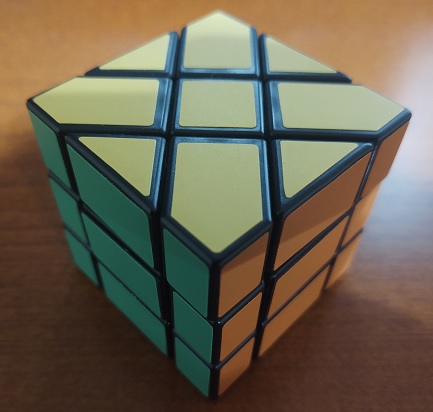

Tony Fisher invented this puzzle in the mid-80s. It's a fun varient of the classic Rubik's Cube. Four of the six cut planes of the Rubik's Cube are simply rotated 45 degrees on an axis perpendicular to a face of the cube.
Start with the layer method, using the white or yellow face as the bottom layer. Solve the first two layers. The third layer is addressed next.
Note, of course, that you must take special care to orient the mid-layer centers (which look like corners), which is one obvious thing that differentiates this from the Rubik's Cube.
At this point we see the only significant reason for this puzzle being slightly harder and more interesting than a Rubik's Cube in that an odd number of edge peices may be flipped. (Remember that edge peices look like corner peices, and vice-versa. What I mean here are peices of the top layer equivilent to edge peices of the Rubik's Cube.)
We must have an even number of edge peices flipped in order to get zero of them flipped as per the usual steps involved in the layer method. The answer to this riddle is simply that one of the edge peices in the middle layer (which looks like a center) needs to be flipped. Since these edge peices look solved in either orientation, you're free to flip any such edge, and then continue with the solve. Doing so, you'll get an even number of mis-oriented edge peices in the top layer, (because edges must be flipped in pairs), and then you can finish the solve.
I go about this by simply bringing up any middle edge peice into the top layer, and then re-slotting it back to where it came from, but in the opposite orientation.